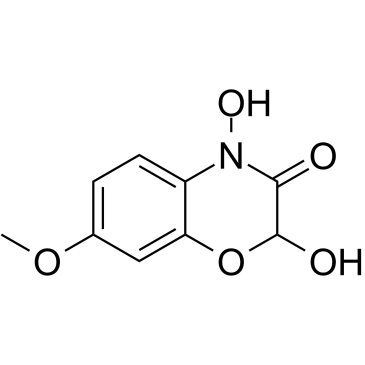DIMBOA |
| Catalog No.GC60138 |
Le DIMBOA, un antibiotique, est un benzoxazinoÏde, qui fait partie du système de défense chimique des plantes graminées telles que le maÏs, le blé et le seigle.
Products are for research use only. Not for human use. We do not sell to patients.

Cas No.: 15893-52-4
Sample solution is provided at 25 µL, 10mM.
DIMBOA (2,4-dihydroxy-7-methoxy-2H-1,4-benzoxazin-3(4H)-one) is a benzoxazinoid (BX), is a secondary metabolite in grasses [1]. DIMBOA act as antibiotic and allelochemical, part of the chemical defense system of graminaceous plants such as maize, wheat, and rye [1,2]. DIMBOA possess growth inhibitory properties against many strains of studied bacteria and fungi, such as Staphylococcus aureus, Escherichia coli as well as against Saccharomyces cerevisiae [2]. Once released, BXs degrade relatively quickly in aqueous environments with a half-life of less than 24 hours [1].
DIMBOA is weak bacterial mutagens and furthermore caused aneuploidy in human-derived liver cells (HepG2 cells) [3]. DIMBOA showed genotoxic effects in HepG2 cell line [4].
DIMBOA showed the antibacterial activity against Ralstonia solanacearum with minimum inhibitory concentrations (MICs) of 50, 100 and 200 mg/L. DIMBOA also significantly affect bacterial growth, reduce biofilm formation, and inhibit swarming motility within 24 h [5].
References:
[1]. Neal A L, Ahmad S, Gordon-Weeks R, et al. Benzoxazinoids in root exudates of maize attract Pseudomonas putida to the rhizosphere[J]. PloS one, 2012, 7(4): e35498.
[2]. Gleńsk M, Gajda B, Franiczek R, et al. In vitro evaluation of the antioxidant and antimicrobial activity of DIMBOA [2, 4-dihydroxy-7-methoxy-2 H-1, 4-benzoxazin-3 (4 H)-one][J]. Natural product research, 2016, 30(11): 1305-1308.
[3]. Buchmann C A, Nersesyan A, Kopp B, et al. Dihydroxy-7-methoxy-1, 4-benzoxazin-3-one (DIMBOA) and 2, 4-dihydroxy-1, 4-benzoxazin-3-one (DIBOA), two naturally occurring benzoxazinones contained in sprouts of Gramineae are potent aneugens in human-derived liver cells (HepG2)[J]. Cancer letters, 2007, 246(1-2): 290-299.
[4]. Buchmann C, Nersesyan A, Kopp B, et al. DIMBOA and DIBOA, two naturally occuring benzoxazinoides, cause aneuploidy in a human-derived liver cell line (HepG2)[C]//BMC Pharmacology. BioMed Central, 2007, 7(2): 1-1.
[5]. Guo B, Zhang Y, Li S, et al. Extract from maize (Zea mays L.): antibacterial activity of DIMBOA and its derivatives against Ralstonia solanacearum[J]. Molecules, 2016, 21(10): 1397.
Average Rating: 5 (Based on Reviews and 13 reference(s) in Google Scholar.)
GLPBIO products are for RESEARCH USE ONLY. Please make sure your review or question is research based.
Required fields are marked with *




